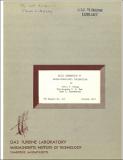| dc.contributor.author | Kiang, David Tien Sik | en_US |
| dc.contributor.author | Tam, Christopher Kwong Wah | en_US |
| dc.contributor.author | Kerrebrock, Jack L. | en_US |
| dc.contributor.other | Massachusetts Institute of Technology. Gas Turbine Laboratory | en_US |
| dc.date.accessioned | 2016-10-06T21:22:00Z | |
| dc.date.available | 2016-10-06T21:22:00Z | |
| dc.date.issued | 1970 | en_US |
| dc.identifier.uri | http://hdl.handle.net/1721.1/104691 | |
| dc.description | October 1970 | en_US |
| dc.description | Includes bibliographical references (leaf 10) | en_US |
| dc.description.abstract | The noise produced by convection of turbulence through an oblique shock wave has been measured and compared to theoretical predictions by Ribner and Kerrebrock. There is excellent agreement with the theoretical prediction that, for a fixed turbulent input, the downstream noise pressure (divided by the mean pressure), should first increase very rapidly, and then decrease as the normal Mach number of the shock is increased from unity to values of the order of 1.5. This behavior implies that a part of the noise from supersonic jets should behave similarly, with a sharp increase, then a decrease as the nozzle pressure ratio is raised from unity. | en_US |
| dc.description.sponsorship | This Research Carried Out in the Gas Turbine Laboratory, M.I.T., in Cooperation with Lewis Research Center, NASA, under Grant NGL 22-009-383 | en_US |
| dc.format.extent | 10 leaves | en_US |
| dc.publisher | Cambridge, Mass. : Gas Turbine Laboratory , Massachusetts Institute of Technology, [1970] | en_US |
| dc.relation.ispartofseries | GTL report #102 | en_US |
| dc.subject.lcsh | Jet planes -- Noise | en_US |
| dc.subject.lcsh | Shock waves | en_US |
| dc.subject.lcsh | Turbulence | en_US |
| dc.title | Noise generation by shock-turbulence interaction | en_US |
| dc.type | Technical Report | en_US |
| dc.identifier.oclc | 09673913 | en_US |
